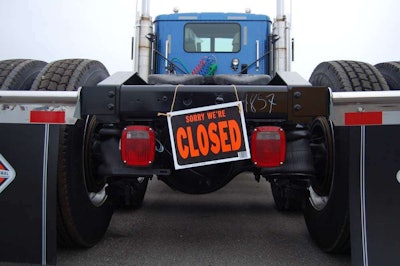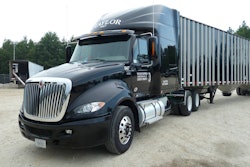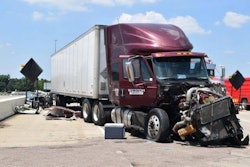Editor’s note: This story was originally published Nov. 8, 2019. Celadon Group abruptly filed for bankruptcy a month later, Dec. 8, and a wave of small to mid-sized-fleets closed their doors in the first six weeks of 2020. With news of carrier bankruptcies popping up again in recent weeks, a look back at this in-depth report on the conditions surrounding bankruptcies and whether they point to industry distress — or simply closures that caught headlines.
 Though a few larger fleet closures drew attention this year, there appears to be little indication of a larger crisis afoot, analysts say.
Though a few larger fleet closures drew attention this year, there appears to be little indication of a larger crisis afoot, analysts say.Carriers in 2018 reaped the rewards of strong rates and tight capacity, but 2019 will close on a much different note, and the return to normal has been difficult for some fleets, leading to layoffs, losses and a few high-profile fleet closures.
“Last year, it was almost impossible to go out of business. You had a historically low failure rate,” said Donald Broughton, principal & managing partner of Broughton Capital.
According to Broughton, 310 carriers called it quits in 2018. By September 2019, more than double that amount – 640 companies – had folded.
“It looks like a dramatic jump, and it indeed it is, but it’s off an extraordinary, all-time low,” Broughton said.
Carriers counted among CCJ’s Top 250 have not been immune. New England Motor Freight (No. 67 in 2018) closed its doors in February and HVH Transportation (No. 231) folded in August. Falcon Transportation and LME, Inc. shut down in April and July respectively. Swift Logistics, a subsidiary of Swift Transportation and the Swift-Knight conglomerate (No. 4), Stevens Transport (No. 38) and Roadrunner (No. 31) all recently announced layoffs.
“While there certainly have been some bankruptcies, including some high-profile bankruptcies in both the LTL and truck loads space, I don’t think there’s been an alarming number of bankruptcies to-date,” said Mark Montague, senior industry pricing analyst at DAT Solutions. “The ones that have occurred have been very high profile because there was an absence of any failures last year with the really good rates.”
Avery Vise, vice president of trucking at FTR Transportation Intelligence, pointed out the overall number of carriers is still higher than last year.
“While we’re losing a lot, we’re also adding a lot and the net so far – and when I say so far, I’m talking about into the first quarter of this year – it’s still a positive, which might surprise a lot of people,” he said.
Total capacity may not have been impacted much by company closures. Vise speculates many of the employees of companies forced out of business didn’t leave the industry.
“When carriers go out of business – and typically we’re talking one, two, three truck operations – quite often they will give up their authority but then they will turn around and begin driving for a trucking company or they’ll sell their truck and become a [company] driver,” Vise said.
The historic market of 2018 was certainly not business as usual but some carriers may have made the mistake of setting that bar as the new normal.
“To the extent that we’re talking about new operators, a lot of them may have simply thought of the market that we had a year – 18 months ago – as sort of standard operating procedure and weren’t really prepared for what a normal market looks like,” Vise said. “And frankly, that’s kind of where we are. We’re not in any – strictly from a demand standpoint – we’re not in any kind of crisis.”
Spot the causes
Though rising insurance rates brought on by records verdicts have certainly chipped away at the bottom line, it’s the spot market that trucking experts say is largely to blame for carriers’ cash woes in 2019.
Unlike contract rates, which are typically locked in for one or two years on fairly predictable supply chains, spot freight is the go-to market where sudden market changes – like a bumper crop of tomatoes or a strong storm – require an expedited deal with a trucking company to get products to market as soon as possible.
During 2018, rising spot rates owed their meteoric rise to various market forces including domestic manufacturing, oil and gas activity, procrastination on ELD acquisition and tough weather.
Relatively moderate diesel prices, corporate tax cuts and surging 401Ks, according to Broughton, also converged to create more a favorable market for trucking.
“What happened in ’18 was that pricing was relatively strong. We had the introduction of ELDs and we had a real surge in economic demand both in the industrial and consumer economies in part because of the cut in corporate taxes, in part because of the demographics and in part because Baby Boomers saw the value of their portfolios or 401Ks surge and decided that they wanted to remodel the bathroom in the house that they’re going to move into and live for the rest of their lives or until someone puts them in a retirement home,” Broughton said. “Or they look at their portfolio and go, ‘It’s so fat, our grandchildren, the Millennials, need help with a down payment on the house and so let’s help them do that.’ Millennials started moving out of the basement. I’m very fond of saying it, millennials MOOB – they MOOB – they moved out of basement. And people said that’s never going to happen, but they were wrong in that prediction.”
DAT, which operates the industry’s largest online marketplace for spot truckload freight, points to raucous weather and ELD holdouts as among the most notable influences on spot demand.
“We can point to several factors, beginning with a series of hurricanes in August and September 2017,” explained Peggy Dorf, senior market analyst at DAT Solutions. “Hurricane Harvey devastated Houston, followed 10 days later by Hurricane Irma on the Atlantic coast. Trucks were diverted away from these regions or used for relief, reconstruction, and resupply efforts just as the peak freight season boosted demand for trucks across the country.
At roughly the same time, Dorf said carriers that waited to comply with the December 2017 ELD deadline faced delays or were momentarily sidelined because ELD providers were backlogged by last-minute installation requests.
“This further reduced the number of trucks available for late-season e-commerce deliveries and post-holiday returns,” she said.
The weather last year was ugly early on and more bad weather was in store, including Hurricane Michael, one of only three Category 5 storms on record to make landfall in the U.S.
“In early 2018, severe winter storms tied up capacity and led to sharp increases in spot rates,” Dorf said. “Even after the weather improved, small carriers and owner-operators were able to make good money while working fewer hours. They spent more time at home, which further constrained capacity.”
Needing more trucks, shippers paid higher contract rates and turned to freight brokers and 3PLs to source additional trucks on the spot market. Carriers enjoyed higher spot and contract rates and, as the money poured in, many bought new equipment and raised driver pay.
“Carriers focused their resources on their contract customers who made less freight available to spot market participants,” Dorf said. “The negotiation balance shifted back in favor of load providers, which caused intense competition among small carriers. The end result: 6% more loads moved on the spot market in the first nine months of 2019 versus the same period in 2018, but rates were 15% lower because capacity grew faster than demand. Contract freight grew more slowly, and rates dropped only 1% compared to their 2018 peak.”
Planning ahead
Minimizing risk is key in staying afloat during market downturns, and while acquiring equipment during the high margins of 2018 may have seemed like a good idea, getting saddled with that debt compounded uncertainty when coffers started running low.
Next year is forecast to look more like 2019 than 2018, so Broughton suggested fleets that struggled to stay afloat this year begin evaluating debt.
“I would sell any unseated trucks,” Broughton said. “I would pay down debt. Strategically, those are the things I would do because carriers who don’t have debt tend to survive.”
Survival also includes streamlining business processes to lower costs.
“It boils down to efficiencies of your operation,” said Doug Schrier, vice-president of product and innovation at Transflo. “One of the big things that you can do to help control your costs is to be able to handle your paperwork in a timely fashion. Get it into your central office to bill your customers as soon as possible and reduce your DSOs (days sales outstanding). It’s amazing to see how much money is hung out there for a carrier.”
Schrier noted carrier average between 35 and 45 days in collecting from shippers, “and you take that and reduce that by one day and you’re going to have more cash flow for your operations and that could potentially be reinvested into things that will make you even more efficient or at the minimum is a reduction in interest expense.”
Massive multi-million dollar verdicts against trucking companies in crash cases have made headlines and rattled insurance carriers — resulting in rising insurance costs.
Michael Nischan, vice president of transportation and risk control at Edgewood Partners Insurance Center, said carriers can expect to see 20% to 30% increases in insurance premiums next year.
Reducing those costs means making safety education a priority throughout the entire fleet, he said.
“Operation Road Check, Brake Safety, Operation Air Brake – all these enforcement events are opportunities to get good data going into the system. That’s really a freebie,” Nischan said. “I prepare all our clients approximately a month in advance of these events by reminding them to ensure that their drivers, number one, understand how to interact with officers during a roadside inspection. Number two, don’t do anything to attract the attention of enforcement.”
Tommy Ruke, founder of the Motor Carrier Insurance Education Foundation (MCIEF), noted that it’s now more important than ever that carriers align themselves with an insurance agent that understands the transportation industry.
“What happens is the motor carrier tells the retail agent, who then takes that information to insurance companies, so that retail agent has to know enough about the trucking business and understand the uniqueness of the trucking business to take that information from that trucker and help them improve and then paint the picture that’s the most favorable one to the insurance provider,” Ruke said. “And the insurance provider is going to have to trust that agent.”
Investing in technology, Ruke added, can not only improve efficiency but also reduce exposure.
“It’s crazy that a motor carrier doesn’t have an event recorder,” Ruke said. “I understand the privacy issue, but that’s for training purposes. What they don’t understand is that the greatest value of the event recorder is to get the insurance carrier to know how immediately to handle a claim. There’s actually more cost savings when we find the motor carrier is at fault than when they’re not at fault. Because if they are at fault then we don’t fight it. We don’t hire attorneys. We don’t pay the $700. We don’t do the reconstruction with claim. If we know we caused it, then we don’t pay all that extra cost.”
Driving down CSA scores needs to be a priority, Nischan added, and that starts with thorough pre- and post-trip inspections.
“It’s about changing the culture,” Nischan said. “It’s about changing behavior and have those policies and procedures. If you have a good disciplinary program, good incentive program, good management team, good training program, then you can impact the culture to where you don’t attract the attention of enforcement. Or, if you do get stopped, for whatever reason, then at least you’re able to demonstrate compliance and get a notice of no violation, which again is good data going into the system.”
Profitability during a downturn becomes easier through diligent risk and cost management.
“You can survive and you can even be profitable in an environment like this if you watch your costs,” Vise said. “You certainly can survive. Whether you can make as much money depends on exactly how much of a swing it was and what your base cost structures are. I think it’s just the case where the very small operators have to be extremely vigilant over cost and also have to put away as much cash as they can. It’s going to be difficult though, in the near term, to build up cash reserves in the environment we’re seeing.”












